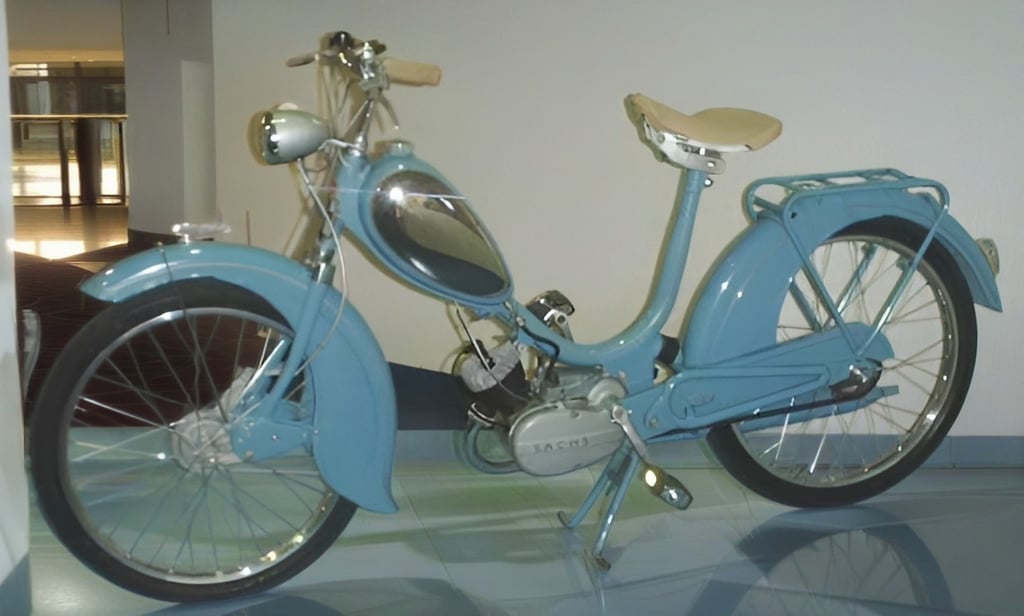The 1955 Maico Wiesel: Innovating Post-War Mobility
The article explores the innovative 1955 Maico Wiesel, highlighting its significance in post-war mobility. It discusses Maico's history, the introduction of the Wiesel model, its use of Sachs and ILO engines, and the lasting impact of this iconic motorcycle on the motorcycle industry.
GERMANY TWO STROKE1950'SVINTAGE MOPEDSMAICO
4/17/20243 min read


The 1955 Maico Wiesel: Innovating Post-War Mobility
Introduction
In the landscape of post-war motorcycle manufacturing, Maico stands out as a beacon of innovation and resilience. Established in 1926 in Poltringen, Germany, Maico swiftly navigated through the ebbs and flows of the motorcycle industry to secure a place in the hearts of enthusiasts worldwide. Among its revered lineup, the 1955 Maico Wiesel emerges as a unique masterpiece, embodying the spirit of post-war mobility with its exceptional design, performance, and use of aftermarket engines by renowned makers Sachs and ILO. This article delves into the history, specifications, and enduring legacy of the 1955 Maico Wiesel, celebrating a model that not only marked a significant era in Maico's history but also shaped the future of motorcycle design.
The Legacy of Maico
Maico, established by Ulrich Maisch in 1926 in the quaint town of Poltringen, Germany, began its journey by manufacturing small two-stroke engines. The aftermath of World War II, however, shifted the company’s focus towards fulfilling the burgeoning demand for personal transportation - a move that saw Maico expanding its expertise into the realm of complete motorcycles. This period marked a significant transformation for Maico, setting the foundation for it to become a revered name in the motorcycle industry. The development and production of motorcycles such as the iconic 1955 Maico Weisel were instrumental in cementing Maico’s legacy as an innovative and resilient manufacturer, capable of adapting to the changing tides of time and technology.
The Birth of the Wiesel
In the mid-1950s, the Maico Wiesel was introduced as a testament to Maico's enduring ingenuity in the face of post-war reconstruction efforts. This model was specifically designed to cater to the needs of a population on the move, seeking reliable and efficient modes of transport. With its compact design, the 1955 Maico Wiesel was ahead of its time, featuring a single-cylinder, two-stroke engine that promised both power and simplicity. Its introduction not only expanded Maico’s product lineup but also demonstrated the company's commitment to innovation and its ability to foresee and adapt to the mobility needs of post-war Europe.
Under the Hood: Sachs and ILO Engines
The 1955 Maico Wiesel distinguished itself not only through its design but also by its strategic use of aftermarket engines, notably from Sachs and ILO. Maico's decision to incorporate engines from these esteemed manufacturers into the Weisel model underscored the company's dedication to quality and reliability. The Sachs engines, celebrated for their robust performance and durability, were a perfect match for the Weisel's requirements, enhancing its agility and efficiency on the road. Similarly, the inclusion of ILO engines, known for their innovative engineering and smooth operation, contributed significantly to the Wiesel's overall performance. This collaboration with Sachs and ILO exemplified Maico's approach to leveraging external expertise to elevate its products, ensuring that the Wiesel remained a paragon of post-war motorcycle engineering.
The Wiesel in the World
Upon its release, the 1955 Maico Wiesel immediately captivated the motorcycle world with its innovative design and superior performance. It quickly became a symbol of the freedom and mobility that were crucial in the post-war era, offering riders a reliable means of transportation that was both affordable and efficient. The Wiesel's widespread acceptance and popularity showcased Maico's ability to understand and meet the practical needs of its customers, further solidifying its reputation in the global motorcycle industry. Today, the Maico Wiesel remains a cherished model among collectors and enthusiasts, its legacy a testament to Maico's role in shaping the future of urban mobility and motorcycle engineering.
Conclusion
The 1955 Maico Wiesel stands as a remarkable illustration of post-war innovation, brilliantly showcasing Maico's capability to integrate leading-edge design with advanced engineering. By adopting aftermarket engines from Sachs and ILO, Maico not only emphasized the importance of performance and reliability but also heralded a new era of motorcycle manufacturing where collaboration and quality took center stage. The Wiesel's influence extended far beyond its immediate post-war context, leaving an indelible mark on the trajectory of urban mobility and motorcycle design. As we reflect on the legacy of the Maico Wiesel, we are reminded of the enduring power of innovation to transform everyday lives, offering new possibilities for mobility, freedom, and adventure. The spirit of the 1955 Maico Wiesel continues to inspire, proving that visionary engineering and thoughtful design are timeless traits that transcend generations.
